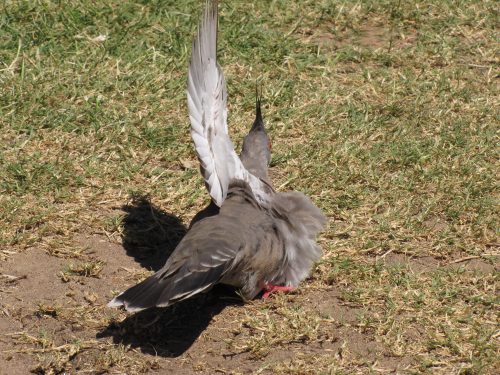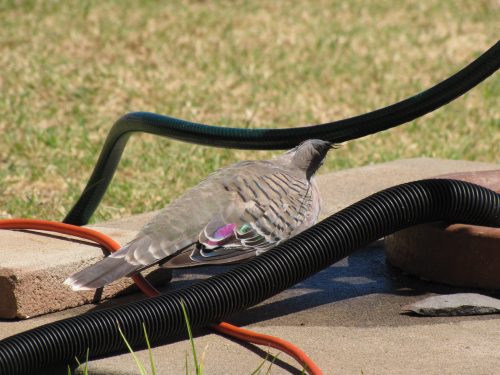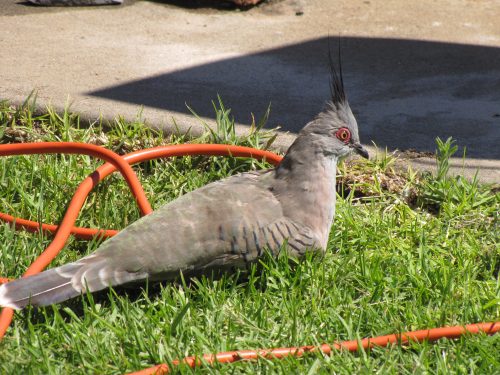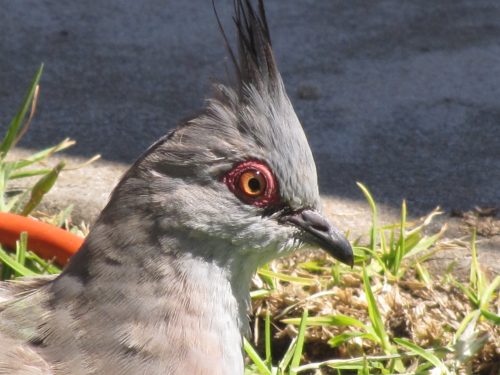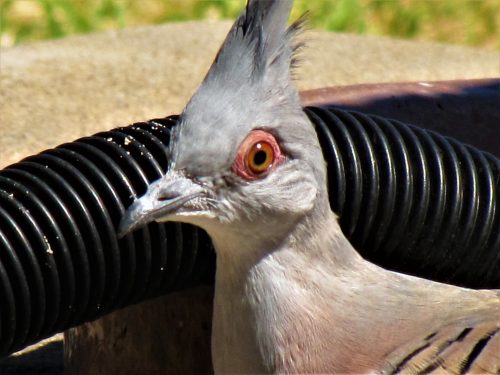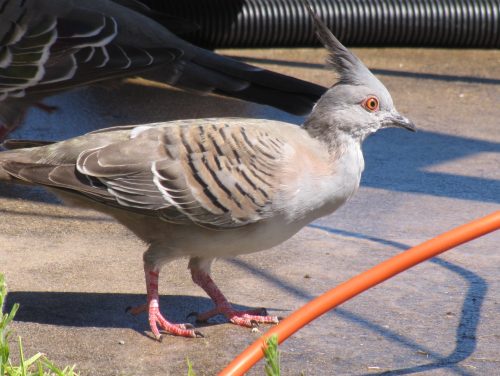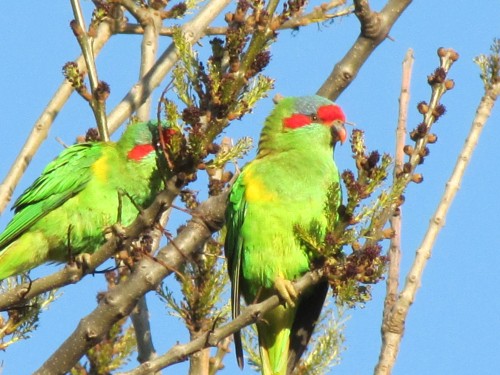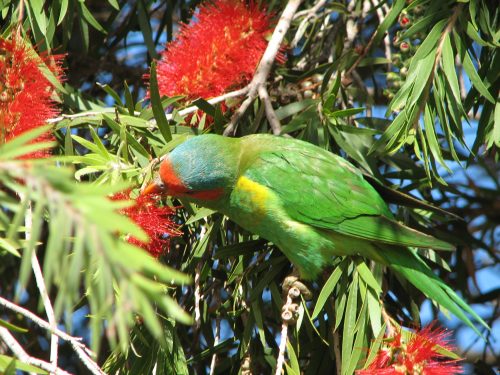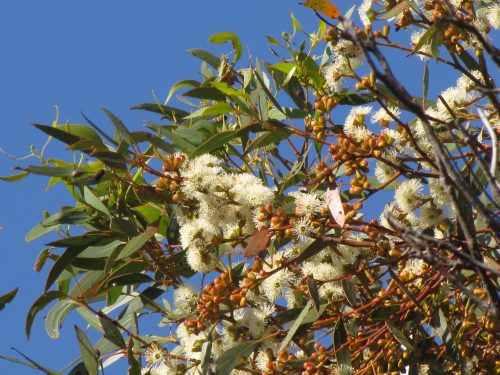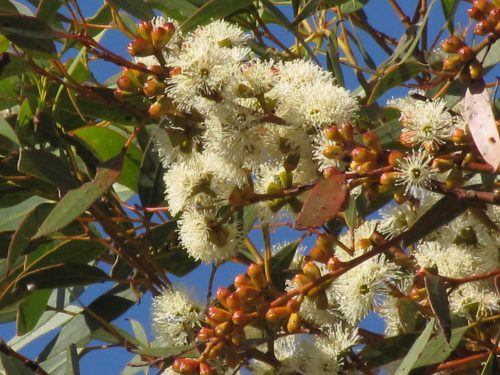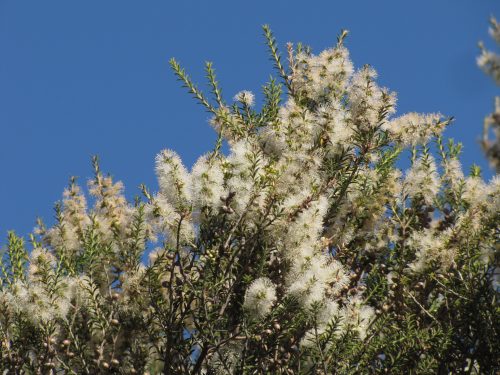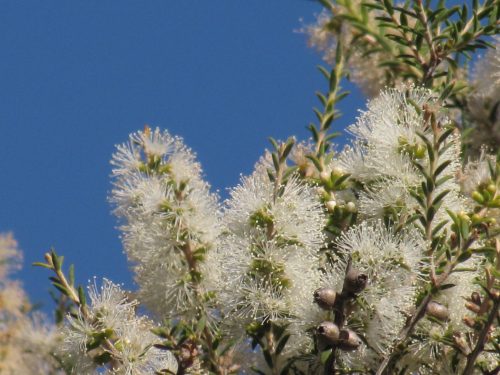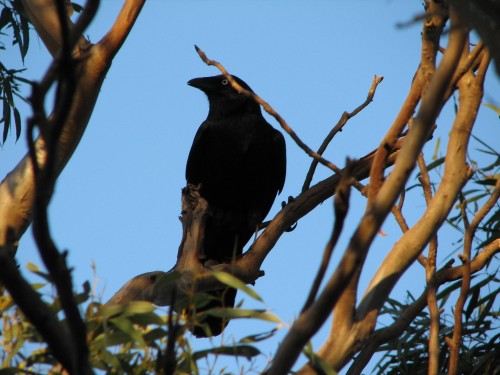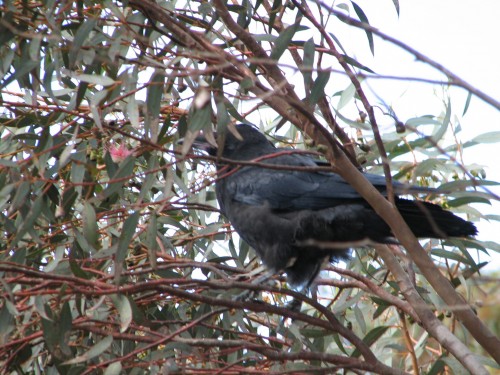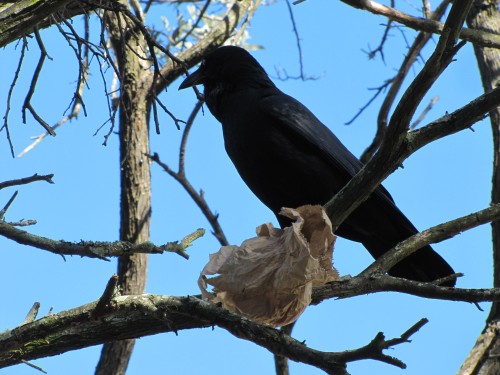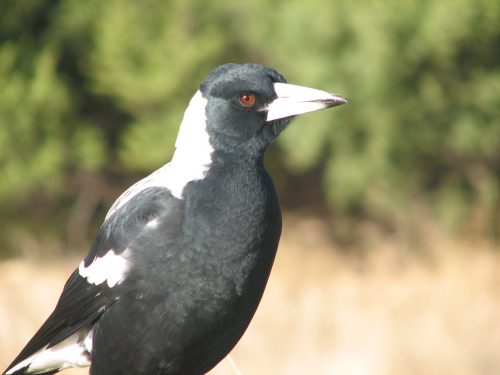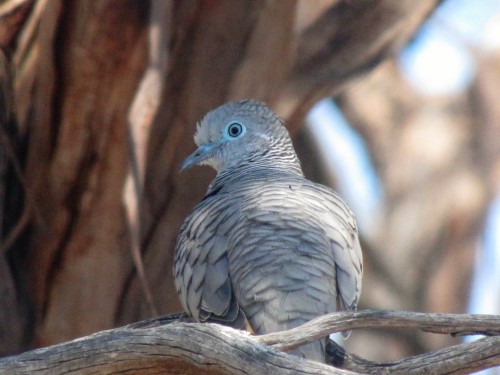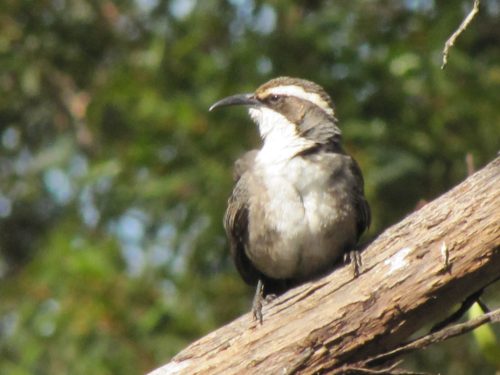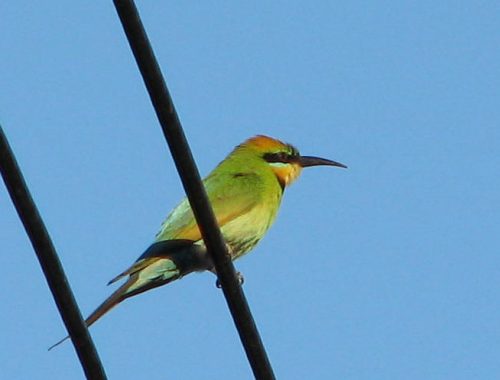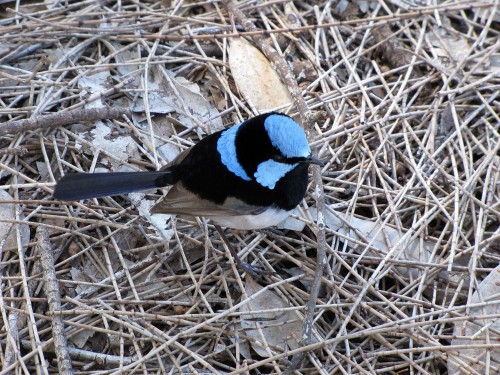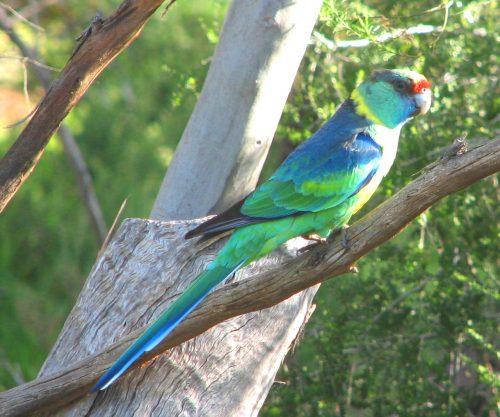Crested Pigeons like to sun themselves
In my last post, I wrote about a recent visit to the Brighton Caravan Park in the southern parts of Adelaide in South Australia. We were staying with several other couples who had also brought their caravans. This lovely park is adjacent one of Adelaide’s best beaches – and there are many wonderful beaches along this stretch of coastline. Our caravan was situated with a good view of the ocean, and only a few steps to the beach.
Over a four day stay at the park, we had many opportunities to just sit a chat with our friends, or gaze out to sea. On the Sunday, we were sitting in the shade of our friend’s caravan having lunch. The park was relatively quiet at that time and a small flock of Crested Pigeons came near to us. They were initially interested in the dripping tap near our van. This tap was attached to the water supply leading to our van. It was quite a warm day and the birds appreciated a little extra water (see photo below).
One of the pigeons decided that it was time to sit in the sun and take advantage of the warm sunlight (see photo at the top of this post). I have seen many birds sunning themselves in this fashion. I wrote a detailed article about this habit here. In this other article, there is a link to a more detailed article on why birds indulge in sunbathing or sunning themselves. In short, it appears that they are trying to rid their plumage of lice.
I guess it also feels nice.
Good birding,
Trevor
Further reading:
Crested Pigeons up close
Last weekend we had a few days away in our caravan. It was only a short break of three nights. Hardly time to settle in and enjoy the lovely beachside caravan park at Kingston Park on the southern edge of Adelaide, South Australia. We stayed in the beautiful Brighton Caravan Park, a most welcoming and well set out and well-maintained park. I wrote about this area after a similar visit last year. You can read about that visit here and here and here.
This caravan park is an easy 90-minute drive from our home. We had the delight of sharing the weekend there with six other couples. Over the weekend all the ladies went to a nearby convention while the men sat around chatting, solving the world’s problems and enjoying the magnificent view over one of Adelaide’s premier beaches. There are so many great beaches near to Adelaide that it is hard to choose one over another.
One of the delights of staying in a seaside caravan park is the birding. On Sunday afternoon, several couples went off exploring, another couple went to a birthday party and my wife and I were left alone to fend for ourselves. We both had books to read and we enjoyed the solitude in such a wonderful, peaceful setting. It was a warm day so we sought out the shady side of our van to read, and to enjoy our lunch.
As we were eating, a small flock of Crested Pigeons flew in and landed a few metres from where we were sitting. They were attracted to the dripping tap near our caravan. Some of them even sat in the pool of water on the slab of concrete around the tap. The birds were only about four metres from where we sat quietly, watching them and admiring the colours on their plumage – more about that in another post in a few days’ time.
I had my camera at the ready, so I was able to take quite a series of close-up photos of the pigeons sunbathing, drinking and generally enjoying themselves in front of us. They were obviously very comfortable with us sitting only a few steps away. I guess that there are people around every day, so they become quite tame. This is a species I have found very easy to approach in most locations.
Over the coming days, I will feature more photos of the birds who came to visit our caravan site.
Good birding,
Trevor
Lots and lots of Lorikeets
An influx of Lorikeets
Over recent days we have had an influx of lorikeets in our garden, on our property and along the road leading to our place here on the edge of Murray Bridge in South Australia.
Normally, we have the odd flyover of a small group of Purple-crowned Lorikeets. Occasionally they will land in one of our mallee trees for a short feed, depending on the extent of flowering at the time. They rarely stay for more than a few minutes.
From time to time we also have Rainbow Lorikeets shooting across the tops of the trees at speed. They are often gone in a flash, flying like colourful arrows against a blue sky. They, too, rarely come to settle in our trees.
The current influx of Musk Lorikeets is somewhat unusual. It is the first time in over 12 years that I have recorded it here in our garden. (My database records only go back that far; I am progressively working back through them.) Although it is relatively common in this area, I haven’t recorded it in our garden in all those years. In fact, if my memory is correct, I have recorded this species in our garden on only a handful of previous occasions, all of them more than 12 years ago.
Why the influx of Musk Lorikeets?
This leads me to contemplate the question: “Why now?”
The reasons are clear and far from complex. The last six to eight months have been exceptional from a weather point of view. From late mid-winter last July (2016) we have had well above average rainfall. This extra rain has produced one of the best flowering seasons for many years over the recent summer months (December – February). The eucalyptus mallee trees have flowered prolifically, along with many other local species of shrubs and bushes. Being predominantly nectar eating birds, Musk Lorikeets have flocked to this area. I don’t mind; I love having them around.
While I was watching them feeding in a mallee tree near to our house earlier this week, something spooked them. They flew off over our orchard, wheeled around to the north, then east and like green coloured screeching darts came hurtling back to the tree near me and recommenced feeding. As they flew, I estimated that there were some 40 to 50 birds, far more than one usually sees in a flock here. Having said that, I have seen large flocks flying together while visiting my daughter in Clare in the mid-north of South Australia.
More photos
I have included below, several photos of some of the trees and bushes currently flowering in our garden. These are what the lorikeets have been feeding on.
Further reading:
- Mallee trees
- Purple-crowned Lorikeets
- Purple-crowned Lorikeets at Brown’s Road Monarto
- Rainbow Lorikeets
- Feeding time at the Zoo
- Close views of Musk Lorikeets
Annoyingly noisy ravens around our house
Over the last few weeks, I have been intrigued, puzzled and just a little annoyed.
Intrigued
I have been intrigued by all of the Little Ravens in our garden, on our five-acre property and along the nearby roadsides. While we only ever have two to five ravens at a time on our block of land, there would have to be at least 50 to 80 in the locality, perhaps more than that within a kilometre of our house. Obviously, there is plenty of food for them, as well as plenty of nesting sites. There is quite an extensive mallee scrub a few hundred metres just to the west of us.
Puzzled
I am puzzled because I am not sure what they are up to at present. Almost every morning this year I have heard large numbers of the local ravens constantly calling. It is usually from just after first light at around 6:30 am up until around 9 am and sometimes a little later. After that, there is just the occasional call as one or two fly overhead, or when they land in one of our trees. I have no idea why they are all calling, or why it stops after a while.
Annoyed
I have also been annoyed with the local Little Ravens, not only because I am puzzled by this behaviour, but it can get a little tedious after an hour or so of this calling, calling, calling. Normally, bird calls do not easily annoy me, though I will concede that if we had 500 Little Corellas wake us up every morning I would definitely change my mind. Thankfully that does not happen, though the local flocks of Galahs can sometimes be rather raucous, though they tend to fly overhead at sunset rather than at dawn.
Dilemma
I, therefore, have something of a dilemma. What are they doing? Why are they calling so incessantly?
I guess I will never know – unless I do an intensive field survey over many weeks in the field when I’d rather be in bed, or reading the paper.
I guess I could always try to learn how to speak Raven.
Good birding,
Trevor
Further reading:
Bird visitors at my window
Over recent days we have had both hot weather and lovely weather. This is normal for mid-summer days here in South Australia. For any new readers, I live about 80km or an hour’s drive south-east of Adelaide. Summer temperatures are usually in the high 20s or low 30s (30C is equal to 86F). During our worst summer days, temperatures can soar as high as 45C (113F), but thankfully such days only occur a few times every year.
Over recent weeks, many days have been in the mid-20s, which is very pleasant. On such days I love to open the large window next to my writing desk and let the fresh air into my office. If there is a breeze as well, that is an added bonus. One of the side benefits of this arrangement is the easy access to the bird life in our garden. I don’t even have to get up out of my chair to watch the birds. They come to me.
One one occasion, a friendly Australian Magpie (see photo above) sat on the rail of the pergola on this side of the house. He was in full view from where I sat. He suddenly stopped his carolling – our magpies are wonderful songsters – realised I was there and leant forward to get a better view of me. When I chatted with him, thanking him for the visit and the song, he answered me. How lovely.
On several occasions over the last week, one or two Peaceful Doves have alighted in the branches of a nearby tree, coo-ing persistently for about ten or fifteen minutes before moving on elsewhere in our garden. Their soft calls are very peaceful, so they are aptly named.
Only yesterday I had to stop what I was writing and look out to the garden bed next to my office window. A small family of White-browed Babblers were playing around in the bushes there, scolding each other as they scurried here and there. They were joined in this game by several New Holland Honeyeaters, their screeches usually a warning sign that a hawk or eagle is about. I think they were just having fun with the babblers. Even a couple of House Sparrows joined in the fun.
One species we don’t always have around is the Rainbow Bee-eaters, a delightfully named bird with their many-coloured plumage and their liking for catching and eating bees and other flying insects. I smile when I see one sitting in a nearby tree, banging a bee against the branch to dispatch the sting of the bee before swallowing it whole. Yesterday two or three could be heard out of my window while I worked, and later I saw two gliding overhead. Delightful birds, and we miss them when they fly north for the winter.
For many years we never had wrens resident in our garden. They were only occasional visitors from up the hill. Then five years ago on our return from an overseas trip, we were greeted by two Superb Fairy-wrens, one of two local species. They have been a resident breeding species in our garden ever since, producing several broods over those five years. They are so secretive about their nests that I have yet to find one. They have plenty of good bushes around to build their nests. From time to time they will also come by my office, their twittering, tinkling calls easy on the ears as they hop along near my office window, jumping up occasionally to snatch a fly or mosquito silly enough to hang around too long.
I don’t need to have the window open to hear our resident Mallee Ringneck parrots screeching outside as they fly from tree to tree, or over the house, or just sitting in a nearby tree wagging their tails joyfully. This tail wagging is probably a mating display. They have raised several broods successfully in recent years, their nest hollow being only 30 metres from my window.
What birds do you have in your garden?
Please tell me in the comments.
Good birding,
Trevor
